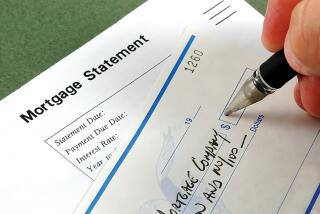Needs Can Change Quickly for Equity Borrowers
- Share via
WASHINGTON — If you’re one of the millions of American homeowners with an active credit line tied to the equity in your house, the odds are strong that you’re not using the money to fix up your property, pay for college tuitions or invest in a business venture.
A new national study of home equity borrowers reveals that, although home improvement was the main reason people took out home equity loans a decade ago, today the name of the game is different.
Borrowers tap their real estate equity primarily to consolidate consumer debts, paying off high-cost credit card, charge account and personal loan balances with lower-cost tax-deductible home equity dollars.
The new study, conducted by two University of Virginia professors for the Consumer Bankers Assn., a banking trade group, found that 36% of home equity credit-line borrowers and 40% of fixed-term home equity loan borrowers describe their principal reason for borrowing as debt consolidation.
The study covered the loan files of a nationwide sample of banks and other mortgage lenders. About 2.3 million home equity loans and credit lines were in the portfolios of the lenders participating in the study.
Fixed-term home equity loans are second mortgages that provide borrowers with a lump sum of money that must be paid back by a fixed date, typically five to 15 years after closing. Fixed-term equity loans almost always carry fixed interest rates.
Home equity lines of credit, by contrast, typically carry adjustable rates. Borrowers are approved for a maximum line of credit secured by their house and can draw down on the approved amount as they choose. They pay interest on only the money they have actually borrowed.
Both types of home equity borrowing are booming in the 1990s, thanks to relatively low interest rates and the tax-deductibility of monthly interest payments.
The average American home equity borrower, according to the study, is between 35 and 49 years old, has an annual household income between $54,000 and $65,000 and has owned his or her home about eight years.
He or she lives in a house valued between $138,000 and $171,000, with an existing first mortgage or deed of trust between $75,000 and $84,000. Home equity line borrowers tend to borrow more--an average line is about $40,000--than fixed-term borrowers, who take out equity loans averaging $25,000.
As recently as 1992, home equity borrowers said their main purpose in getting a second loan was to put on an addition or do other improvements to the house. Now only 27% of equity line borrowers use the proceeds for property fix-ups. Nine percent use their equity funds to pay for educational expenses, 6% buy cars and 3% use the money for investments.
Most credit line borrowers actively tap into their equity accounts during the course of a year--11 times on average, according to the study. Although most equity line borrowers access their accounts by check, 37% of the lenders surveyed allow them to use automated teller machines, 43% allow access over the phone and 17% offer home equity-line credit cards. Using such a card, homeowners can charge a meal at a restaurant--or a bag of groceries at the supermarket--by tapping their home equity nest egg, at tax-deductible rates.
Lenders promote home equity loans aggressively in part because they are less risky than other forms of credit.
The study found that, whereas 1.77% of traditional categories of consumer finance--auto loans, boat loans, personal loans--are 30 days or more delinquent on average, just 1.37% of equity line borrowers are behind on their monthly payments.
Banks also like the fee income equity loans and credit lines generate. Equity line borrowers paid an average $346 in fees last year, up from $224 in 1995 and $197 in 1994, according to the study. Fixed-term equity loan borrowers paid even more to get their credit, an average $459 per loan last year compared to $200 in 1995.
One of the hottest trends within the home equity loan field: loans that allow borrowers to pocket 100% or more of the available equity in their houses.
The study found that two-thirds of the lenders surveyed now offer programs permitting borrowers to take out equity loans or credit lines that, when added to the debt balance on their primary mortgage, equal the total appraised value of the home.
You might, for example, have a first mortgage of $150,000 on your $200,000 home, and then take out a $50,000 equity loan. In the past, lenders rarely allowed the combined first mortgage and equity loan to exceed 80% to 90% of the value of the home.
But here’s the kicker: The study found that some banks now allow homeowners to hock their homes to the hilt and then some. Three percent of the lenders said they make equity loans where there’s negative equity, when the combined first and second mortgages equal 101% to 125% of the home’s appraised resale value.
*
Distributed by the Washington Post Writers Group.
More to Read
Inside the business of entertainment
The Wide Shot brings you news, analysis and insights on everything from streaming wars to production — and what it all means for the future.
You may occasionally receive promotional content from the Los Angeles Times.










